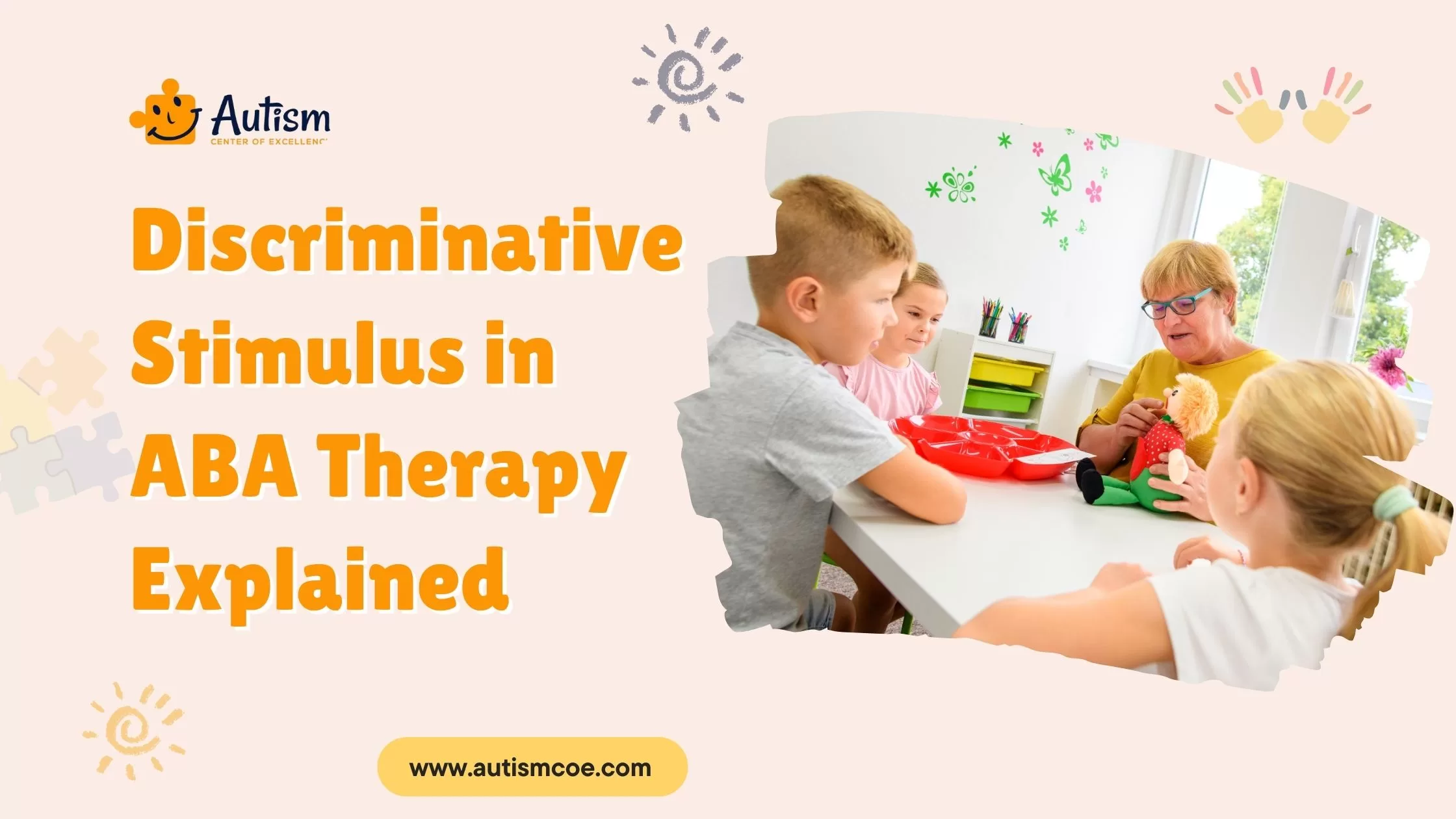ABA therapy is one of the most highly esteemed approaches in behavior modification specific to clients with developmental disorders such as autism. Scientific principles form the basis on which ABA therapy grounds, and it further emphasizes systematic interventions and reinforcements. Basically, this therapeutic model is in the center of the discriminative stimulus (SD). It is part of what influences the change in behavior and learning.
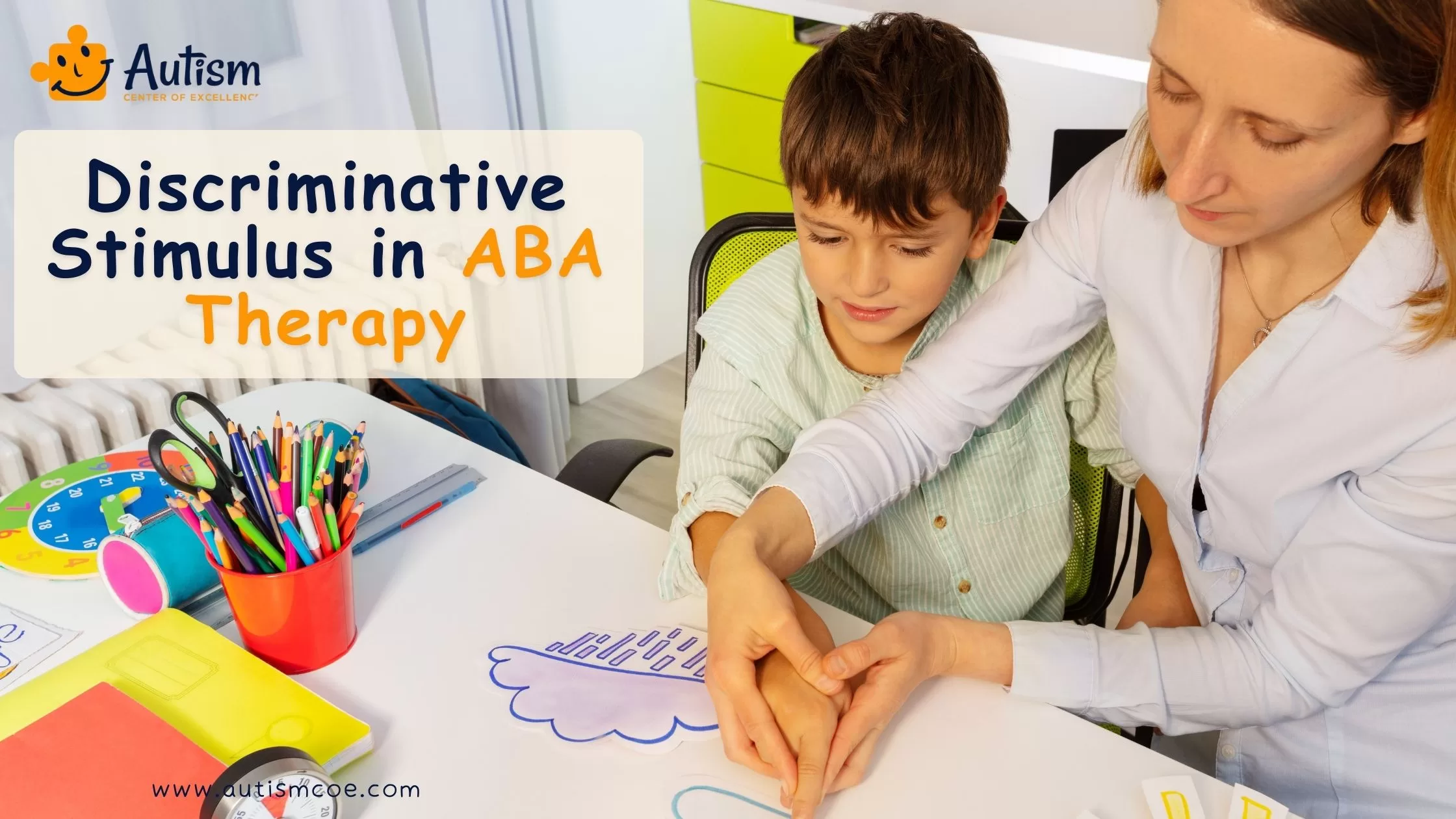
What is a Discriminative Stimulus?
A discriminative stimulus refers to a specific Applied Behavior Analysis term where an individual is signaled of the existence of reinforcement to carry out a specific behavior. It acts as a cue that lets the person know that whenever he demonstrates a certain behavior when this stimulus exists, then he stands to be rewarded or benefit from a favorable outcome. This would therefore give a greater probability for this behaviour to occur under the same conditions once more.
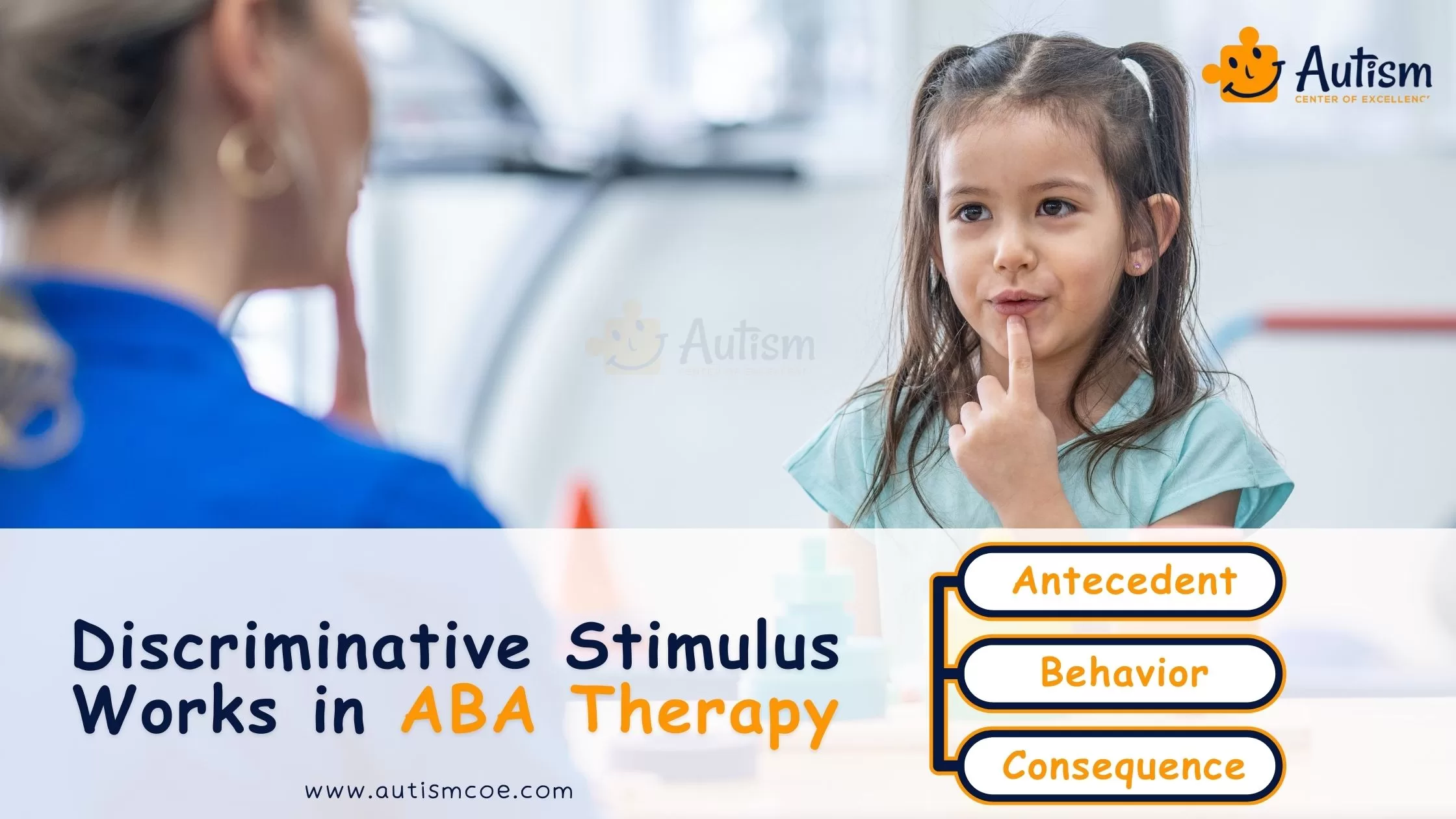
How Discriminative Stimulus Works in ABA Therapy
In ABA therapy, the discriminative stimulus (SD) functions as part of the ABA model: Antecedent, Behavior, and Consequence. Here’s how it works:
#1. Antecedent (Discriminative Stimulus):
The SD is a cue or signal that elicits a specific behavior. It prompts a person that a particular behavior will be reinforced if performed.
#2. Behavior:
This is the act or reaction that happens in the presence of the SD. The person will exhibit the behavior once they have an expectation about the positive outcome.
#3. Consequence:
When the behavior has occurred, a consequence is delivered. Commonly, in the case of appropriate or the desired behavior, the consequence applied is a positive reinforcement, like praise, rewarding, or some other form of encouragement.
The SD increases the likelihood that the behavior will be emitted because the individual finds out that emitting the behavior in response to the SD results in a positive consequence. In the long run, it helps significantly in molding and changing behaviors.
Join Our Weekly Newsletters!
Subscribe now to stay updated with our latest email updates.

Importance of Discriminative Stimulus in Behavior Modification
Discriminative stimuli play a vital role in modifying behaviors for the following reasons:
Cueing Behavior:
They give clear signals that will inform people of which behavior can be rewarded so they can acquire the new behaviors.
Learning:
The consistent pairing of specific stimuli with desired outcomes enables individuals to learn quickly what behaviors are liked and speeds up the process of learning.
Consistency:
A discriminative stimulus lays out a structured framework where behaviors are reinforced in a predictable way; such makes the outcome of changes in behavior even more stable.
Skill Acquisition:
In therapy, SDs are used in the acquisition of a new skill as it informs the individual of which behavior will give them a reward so that they can practice and acquire the new skill.
Communication:
For individuals who have challenges related to communication, SDs can be non-verbal cues to assist them in understanding expectations and giving an appropriate response.
Overall, discriminative stimuli act as important conduits in ABA therapy and other applications of behavior modification towards conditioning and developing targeted behaviors.
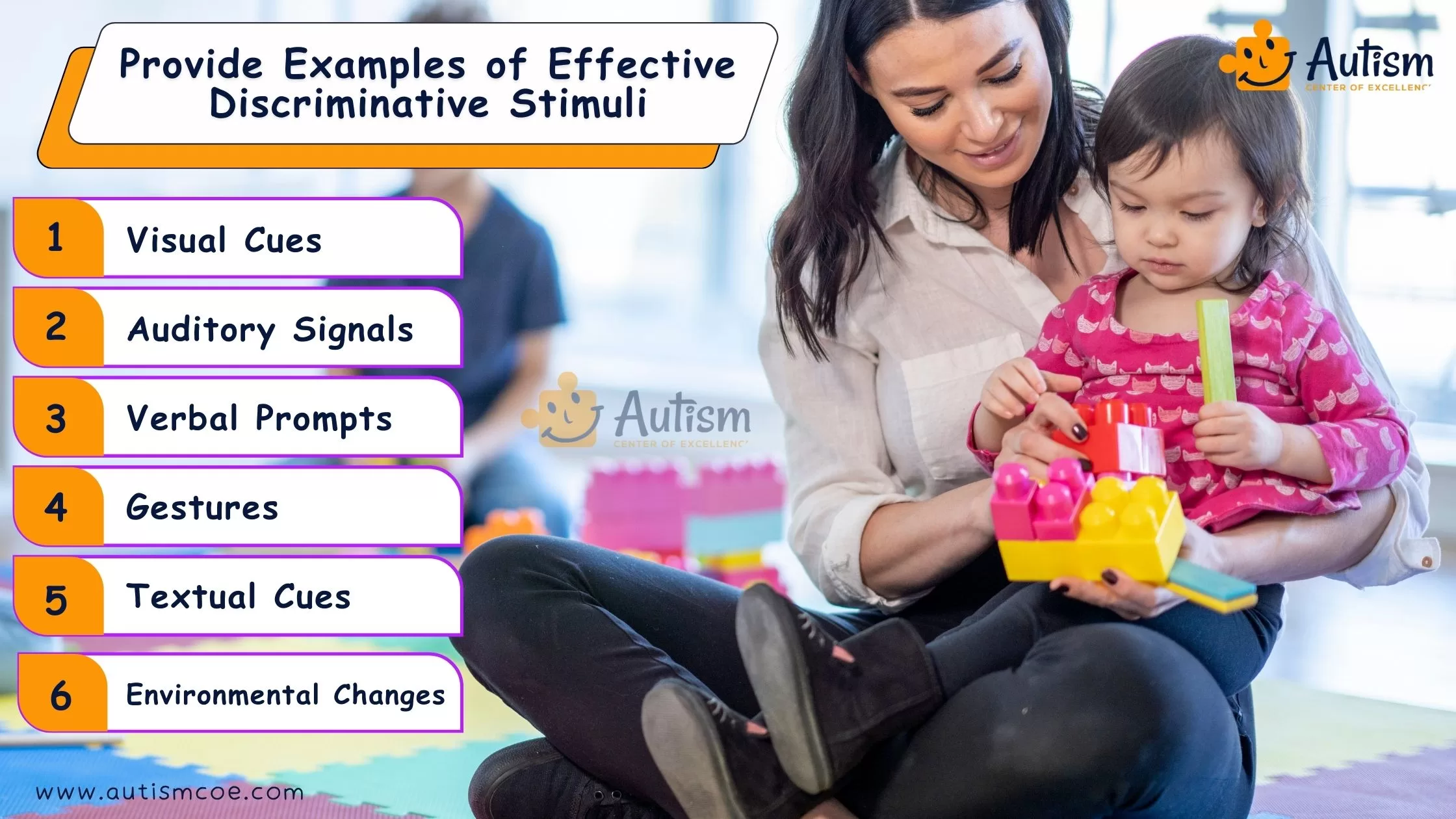
Provide Examples of Effective Discriminative Stimuli
Here are some examples of effective discriminative stimuli used in various contexts:
#1. Visual Cues:
A stop sign may be an SD in a classroom to point out to the students that they should stop talking and pay attention. It is clear and universal so it works for classroom management.
#2. Auditory Signals:
The bell at the end of a period is an SD to signal the students to pack up and move to the next class. It is unique and always linked with the end of a particular period.
#3. Verbal Prompts:
In a therapy session a therapist may use the phrase “What do you say?” as an SD to encourage the child to say “please” or “thank you.” One is simple and straightforward.
#4. Gestures:
A thumbs up may be an SD to reinforce continuation of a good behavior like sharing toys. It is simple and immediate feedback.
#5. Environmental Changes:
Dimming the lights in a space might be an SD that signals to kids to calm down and prepare for a quiet activity such as reading or meditation.
#6. Textual Cues:
An SD for someone diagnosed with an autism disorder can include a written schedule or checklist to assist a child in moving from one activity to another by creating a clear visual of what is to come.
Examples like these demonstrate just how discriminative stimuli can be varied to fit the needs of various environments and requirements. In this way, they can become useful instruments for changing the behavior of a person.
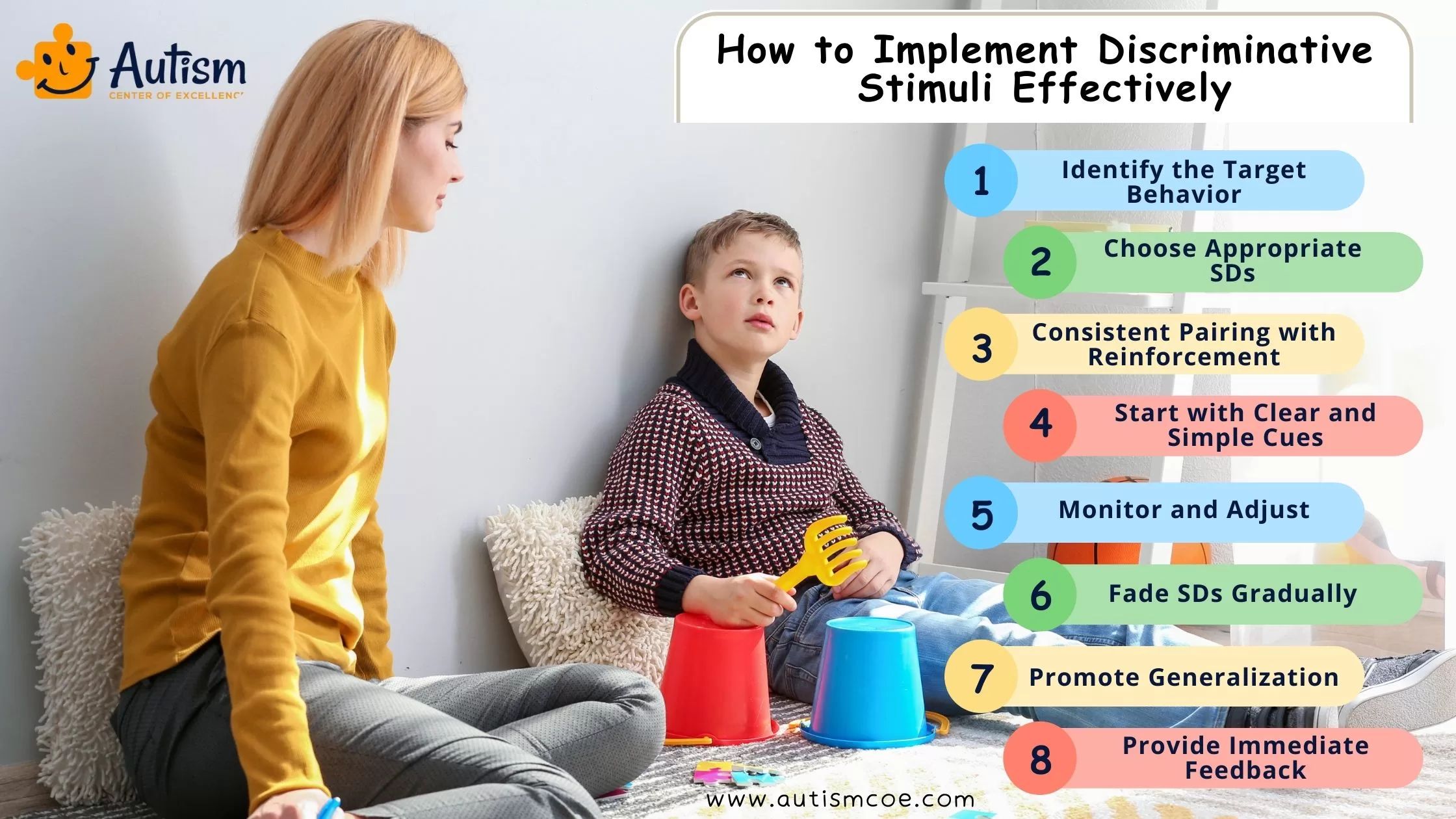
How to Implement Discriminative Stimuli Effectively
Effective application of discriminative stimuli in ABA therapy makes necessary the following steps. They are clear; consistent, and supportive of the learning process. Here’s how you might be able to do this
Identify the Target Behavior:
Clearly define the behavior you want to increase or decrease. This will enable you to pick the appropriate SD that will indicate the presence of reinforcement for a particular behavior.
Choose Appropriate SDs:
Select SDs which are observable and meaningful for the person. Selection of visual, auditory, or even tactile cues may depend upon his personal preference and necessity.
Consistent Pairing with Reinforcement:
Pair the SD with reinforcement, each time that the desired behavior occurs. That way, an association forms in the individual’s mind linking the SD to the desired outcome.
Start with Clear and Simple Cues:
Begin with clear simple cues which the individual can respond well to. As this progresses, introduce more complex cues if necessary.
Monitor and Adjust:
Observe continuously how the person responds to the SDs. If the behavior has not been displayed as expected, you might have to modify the type of SD or even the type of reinforcement.
Fade SDs Gradually:
Once the behavior is learned, fade the SDs. Fading can be done in two ways: first, reduce the prominence, then gradually diminish the frequency of using the SD, while simultaneously continuing to reinforce the behavior.
Promote Generalization:
Encourage the client to react to SD in various contexts and situations for maximal generalization, that is, learning the behaviour not only in an initial context or situation but also outside of the first learning context.
Provide Immediate Feedback:
Reinforce desired behavior immediately after its manifestation resulting from SD, to establish and increase strength of association so that the person has a chance to reenact the behavior.
The steps enumerated above can be carried out to offer discriminative stimuli that will influence and Reinforce Desired Behaviors by a Powerful Tool in Aba Therapy.
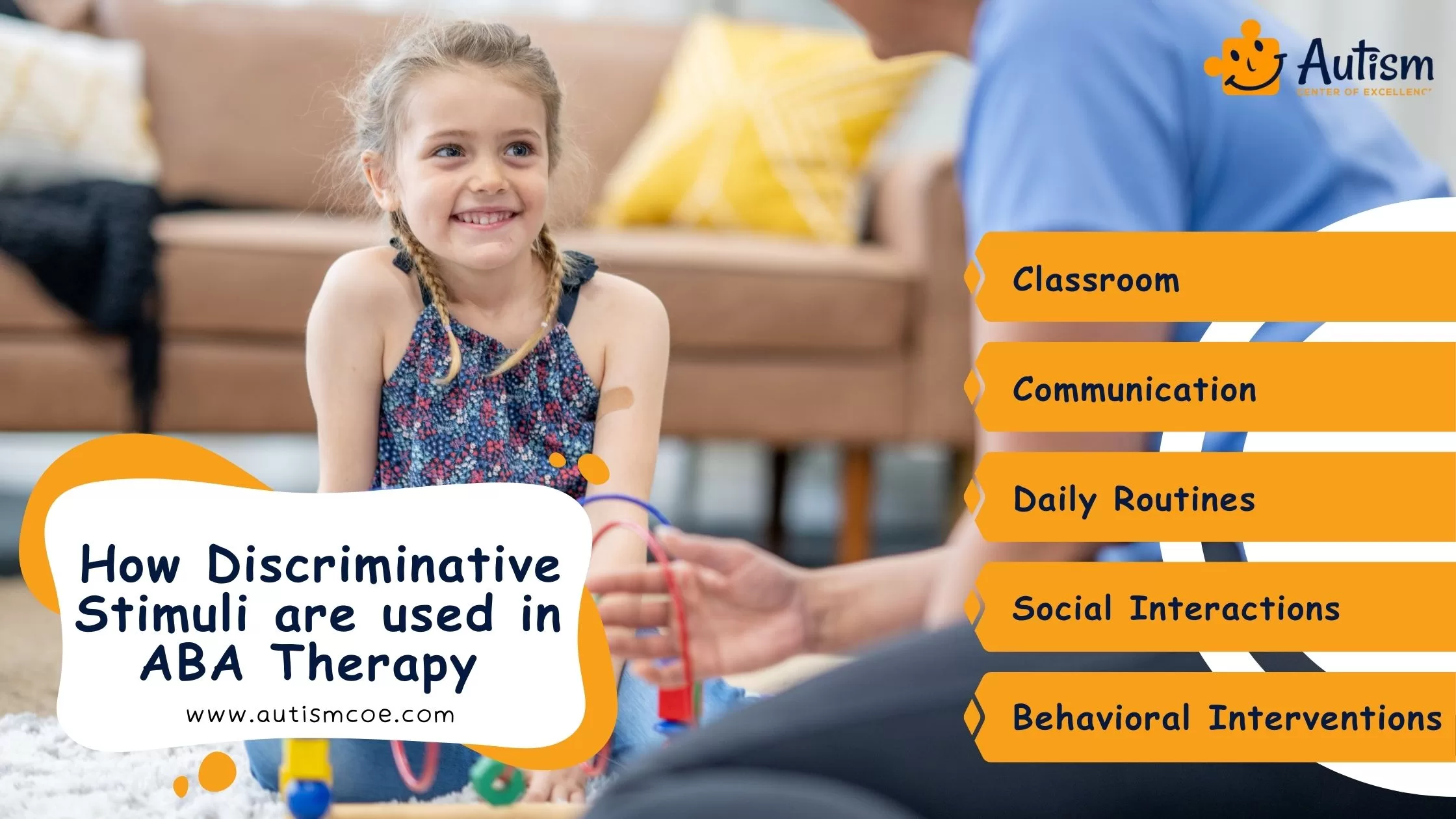
Here are Some Examples of How Discriminative Stimuli are Used in ABA Therapy
#1. Classroom:
A teacher can use a particular hand gesture as a SD so that the students will know when to be quiet and attend. Once they catch this cue, they understand that upon the fulfillment of the instruction that the signal indicates, it follows that they will be rewarded or praised.
#2. Communication:
A therapist teaches a child to request items by holding up a picture of a toy (the SD) and asking the child to say the name of the toy. If the child, upon seeing the picture of the toy, says the name of the toy he gets the toy as reinforcement.
#3. Daily Routines:
For an autism child, a picture schedule may be an SD of the next activity in this routine. A picture of a toothbrush may suggest that it is time to brush teeth; the completion of this task might lead to some additional playtime.
#4. Social Interactions:
A verbal cue- “What do you say?”-can be an SD by a therapist when teaching social skills training to a child in order to elicit polite language, like “please” or “thank you”. He will be praised with small treats for proper usage of those phrases.
#5. Behavioral Interventions:
In reducing problem behaviors a given sound or gesture may be used as an SD to indicate that a preferred activity is available if the individual demonstrates a positive alternative behavior in place of the problem behavior.
The examples above clearly illustrate the systematic use of discriminative stimuli in Aba Therapy to Help Guide and reinforce wanted behaviors, so it logically becomes a part of any effective strategy to modify behavior.
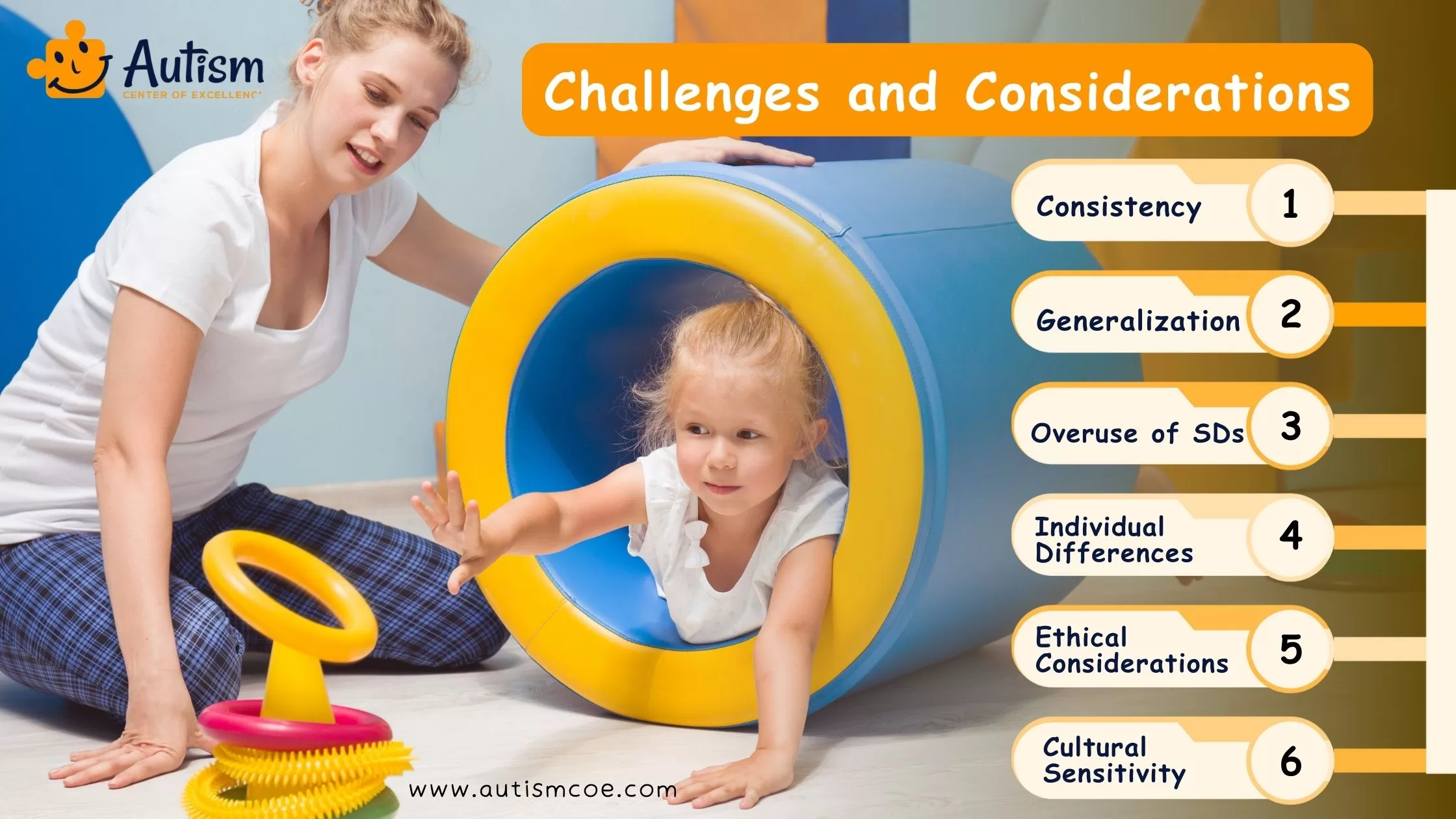
Challenges and Considerations
When working with discriminative stimuli in ABA therapy, there are quite a few challenges and considerations to remember:
Consistency:
You have to be able to consistently pair the discriminative stimulus with the reinforcer so that the person will know when they got it right or wrong. Inconsistent reinforcement causes confusion and renders the SD somewhat useless.
Generalization:
One of the biggest challenges is to ensure that what one has learned in the presence of a given SD can be generalized to other conditions or stimuli. You have to plan for and facilitate that generalization so that the behavior is of utility to you in real life.
Overuse of SDs:
People may become so reliant on specific cues to do behaviors that they’re overdependent. You need to fade the SDs to encourage independent behavior.
Individual Differences:
Every person will respond differently toward different stimuli. What will work as an SD for one person may not work for another; therefore you need individualize.
Ethical Considerations:
Use of SDs and contingently applied reinforcers must also be ethical and in the best interest of the individual. These are issues of autonomy and respect.
Cultural Sensitivity:
Your choices of SDs must be culturally appropriate and sensitive to the individual’s background and experience.
Handling these challenges and considerations makes it feasible for therapists to succeed in using discriminative stimuli to help bring about meaningful and lasting behavior change.

List Common Misconceptions About Discriminative Stimuli
Here are some common misconceptions about discriminative stimuli:
#1. Always Verbal:
Many people think discriminative stimuli are always verbal cues. Discriminative stimuli can be any type of sensory input, visual, auditory, or tactile.
#2. Same as Reinforcement:
In many cases, people get confused with discriminative stimuli with reinforcement. An SD signals the availability of reinforcement, but is not the reinforcement itself.
#3. Only Used in Therapy:
Many think that discriminative stimuli are used only in therapy. But they are plentiful in everyday life, “telling us what situation to behave,” as Skinner wrote, for example, traffic lights instructing us to stop or go.
#4. Automatically Effective:
There’s a myth that once the SD has been presented, behaviour will have changed. It takes regular pairing with reinforcement and planning.
#5. Only for Children:
Some people believe that discriminative stimuli are applied to children or even only to kids with learning disabilities. Wrong again: They apply the same thing for all ages and groups in behavior modification.
#6. Rigid and Unchanging:
Some may assume that, once SD is established, it stays the same. Wrong. SDs have oftentimes to change or fade out with time to encourage independence and generalization.
If misconceptions are understood, then it is possible that the role of discriminative stimuli in behaviour modification will be cleared further.
Frequently Asked Questions & Answer
How Is a Discriminative Stimulus Used in ABA Therapy?
In ABA therapy, a discriminative stimulus (SD) is used to indicate that a particular behavior will be followed by reinforcement. It helps the individual understand when to perform specific actions. For example, if a therapist says, “Sit down,” and the child sits, the therapist might offer praise or a reward. Over time, the child learns to associate the instruction with sitting and the positive outcome that follows.
How Does a Discriminative Stimulus Differ From a Prompt?
While both discriminative stimuli and prompts guide behavior, they serve distinct roles. An SD signals the availability of reinforcement for a specific behavior, whereas a prompt is an additional aid to encourage the behavior. For instance, the SD might be “Pick up the book,” while a prompt could involve physically guiding the child’s hand toward the book to initiate the action.
Why Is Discriminative Stimulus Important in ABA Therapy?
Discriminative stimuli play a critical role in helping individuals learn which behaviors are appropriate in different settings. By repeatedly associating certain cues with specific responses and reinforcement, individuals with autism can develop more adaptive behaviors, promoting greater independence and smoother transitions across environments.
Can Discriminative Stimuli Be Used Across Different Environments?
Yes, discriminative stimuli can be applied across various settings, such as home, school, or therapy environments. For example, the SD “Wash your hands” can be taught at home and then generalized to other environments like school or public spaces, encouraging the individual to respond appropriately regardless of where they are.
Conclusion
Discriminative stimuli is one of the most important features of ABA therapy because they guide the individual towards specific desired behaviors and help to learn through reinforcement. Proper utilization of SD’s by therapists can easily improvise results from the modification programs. Additional resources and professional organizations can be found to increase further enlightenment regarding ABA therapy and its methods.
Please Note: The content of this blog is for informational purposes only and should not be considered a substitute for professional medical advice, diagnosis, or treatment. Consult a qualified healthcare professional for personalized guidance tailored to your specific situation.

Bhavika Bhasin
Bhavika Bhasin is the Research and Marketing officer at AutismCOE. She works with children and adults with ASD. Her clinical research includes evaluating various available autism screening and diagnosis methods and their efficacy. She is currently developing a novel screening exam that is indicated to be more accurate than the existing available exams. She is also writes articles papers for various publications.


